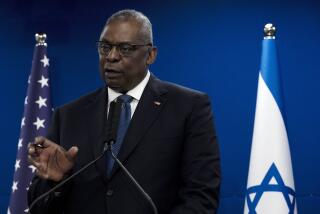U.S. Plans Joint Operations With Multinational Forces : Military: Commanders overcome Saudi objections, will stress coordination in field.
- Share via
DHAHRAN, Saudi Arabia — Faced with battlefield communications problems so severe that they could result in U.S. forces accidentally attacking their Arab allies, American commanders have overcome Saudi diplomatic objections and soon will begin joint operations with other units in the multinational force deployed here, according to senior officials.
The combined operations, scheduled to begin in the next two weeks, would mark a major step toward improving on-the-ground coordination among the various nations fielding troops as part of the international effort to shield Saudi Arabia from future Iraqi aggression.
Although the amalgam of Western, Asian and Arab forces has provided a crucial international base for the stand against Iraqi President Saddam Hussein, military officials fear that its effectiveness in the heat of battle could be undermined by incompatible communications equipment and easily confused weapons systems.
Of particular concern is the fact that some of the Soviet-made arms deployed by Syria, Egypt and other unlikely new U.S. allies look much like those used by Iraqi forces, creating the possibility of friend firing on friend.
“It’s something we’re worried about,” Brig. Gen. James M. Myatt, commander of Marine ground forces in the theater, said in an interview this week in a forward-based command post not far behind the Arab-held front lines.
Added Col. Robert N. Siegle, whose Army aviation units could be asked to assist in ground battles pitting Arab armor against Iraqi tanks: “You’ve got such a terrific variety of equipment that it’s going to take some time for our guys to figure out who’s on whose side.”
The new arrangement, which bridges Saudi Arabia’s initial desire to keep U.S. forces at arm’s length from its own troops, reflects the challenge faced by allied commanders in making the novel multinational defense force actually work.
Until now, the forces have operated largely independently, with Arab troops deployed in a thin line near the border between Iraq and Kuwait, well ahead of U.S. Army and Marine contingents that have established separate sectors behind them.
But U.S. commanders believe the need for coordination would grow more acute in a war as U.S. forces rushed to more forward postions or Arab forces withdrew to more secure positions.
Military officials said a primary goal would be to work toward tactical collaboration to avoid mistaken identities on the battlefield.
“When push comes to shove,” Marine Lt. Gen. Walter E. Boomer said in an interview Wednesday, “and two guys that are fighting side by side, they are the ones who’ve got to work out the details.”
U.S. and Saudi officials said that the joint command structure appears well coordinated at the top, with Gen. H. Norman Schwarzkopf working closely in the capital city of Riyadh with his Saudi counterpart, Prince Sultan ibn Abdulaziz, commander of all Muslim forces.
But top American officers said that such partnerships have not yet been adequately forged down the chain of command, with crucial U.S. divisions lacking designated liaison officers who represent the friendly forces lying between them and Kuwait.
Coordination in desert warfare is regarded by military experts as particularly important because of the terrain, in which skirmishing allied Arab and Iraqi forces could quickly wind up in overlapping positions. Or allied Arab armies could be forced by an Iraqi attack to pull back through U.S. lines in a withdrawal regarded as nightmarish even when well-rehearsed.
“It’s difficult,” said Boomer, commander of all Marine forces here, noting that the United States has worked with some of its allies “for years” to iron out such coordination problems. “In this case,” he said, “we haven’t.”
But the general said that initial steps already taken by the United States and its Arab allies have ensured that “we’re not staring disaster in the face at all.”
Other field officers, however, said they are not yet confident about how Arab forces would behave in combat and acknowledged that the problem of distinguishing friend from foe remains among their principal concerns.
“If you talk about a mix-up hypothesis,” said Col. Dave Sawyer, commander of the Air Force’s A-10 “tank killer” aircraft in Saudi Arabia, “that’s going to be a real challenge.”
U.S. Apache helicopter pilots have been ordered to drill with flash cards to sharpen their ability to distinguish between enemy and allied forces and equipment. Other American aviation units are making frequent overflights to see the weapons firsthand.
One plan calls for U.S. forces and their allies to apply special luminescent markings to their vehicles so that they can be easily identified by friendly forces.
The allied Arab forces, which consist of a previously created unit representing the Gulf Cooperation Council and the new alliance of Muslim armies, include units ranging from Syria and Egypt to Qatar and Morocco, all under Saudi central control.
On the Western side of the alliance, the British government has said its forces will operate under the control of the United States, with a senior British commander to join the staff of the U.S. commander in chief. But the French have made no such commitment, leaving them likely to function as a third force independent of the U.S. and Saudi blocs.
Saudi officials have downplayed coordination problems, noting that Prince Sultan and other top Saudi generals, as commanders of the Muslim forces, work closely with U.S. commanders.
More to Read
Sign up for Essential California
The most important California stories and recommendations in your inbox every morning.
You may occasionally receive promotional content from the Los Angeles Times.













